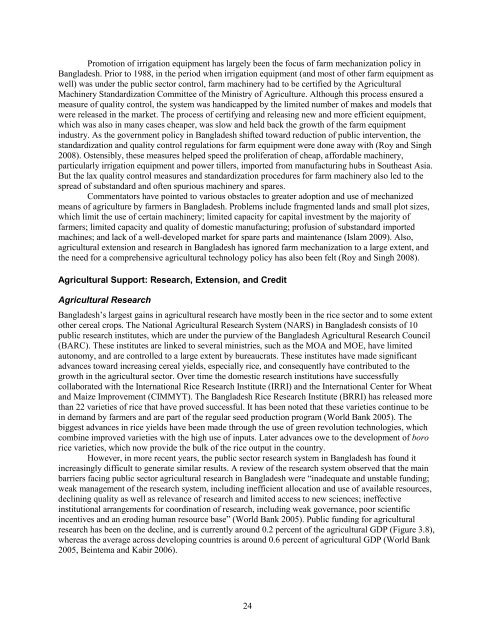Review of Input and Output Policies for Cereal Production in ...
Review of Input and Output Policies for Cereal Production in ...
Review of Input and Output Policies for Cereal Production in ...
Create successful ePaper yourself
Turn your PDF publications into a flip-book with our unique Google optimized e-Paper software.
Promotion <strong>of</strong> irrigation equipment has largely been the focus <strong>of</strong> farm mechanization policy <strong>in</strong><br />
Bangladesh. Prior to 1988, <strong>in</strong> the period when irrigation equipment (<strong>and</strong> most <strong>of</strong> other farm equipment as<br />
well) was under the public sector control, farm mach<strong>in</strong>ery had to be certified by the Agricultural<br />
Mach<strong>in</strong>ery St<strong>and</strong>ardization Committee <strong>of</strong> the M<strong>in</strong>istry <strong>of</strong> Agriculture. Although this process ensured a<br />
measure <strong>of</strong> quality control, the system was h<strong>and</strong>icapped by the limited number <strong>of</strong> makes <strong>and</strong> models that<br />
were released <strong>in</strong> the market. The process <strong>of</strong> certify<strong>in</strong>g <strong>and</strong> releas<strong>in</strong>g new <strong>and</strong> more efficient equipment,<br />
which was also <strong>in</strong> many cases cheaper, was slow <strong>and</strong> held back the growth <strong>of</strong> the farm equipment<br />
<strong>in</strong>dustry. As the government policy <strong>in</strong> Bangladesh shifted toward reduction <strong>of</strong> public <strong>in</strong>tervention, the<br />
st<strong>and</strong>ardization <strong>and</strong> quality control regulations <strong>for</strong> farm equipment were done away with (Roy <strong>and</strong> S<strong>in</strong>gh<br />
2008). Ostensibly, these measures helped speed the proliferation <strong>of</strong> cheap, af<strong>for</strong>dable mach<strong>in</strong>ery,<br />
particularly irrigation equipment <strong>and</strong> power tillers, imported from manufactur<strong>in</strong>g hubs <strong>in</strong> Southeast Asia.<br />
But the lax quality control measures <strong>and</strong> st<strong>and</strong>ardization procedures <strong>for</strong> farm mach<strong>in</strong>ery also led to the<br />
spread <strong>of</strong> subst<strong>and</strong>ard <strong>and</strong> <strong>of</strong>ten spurious mach<strong>in</strong>ery <strong>and</strong> spares.<br />
Commentators have po<strong>in</strong>ted to various obstacles to greater adoption <strong>and</strong> use <strong>of</strong> mechanized<br />
means <strong>of</strong> agriculture by farmers <strong>in</strong> Bangladesh. Problems <strong>in</strong>clude fragmented l<strong>and</strong>s <strong>and</strong> small plot sizes,<br />
which limit the use <strong>of</strong> certa<strong>in</strong> mach<strong>in</strong>ery; limited capacity <strong>for</strong> capital <strong>in</strong>vestment by the majority <strong>of</strong><br />
farmers; limited capacity <strong>and</strong> quality <strong>of</strong> domestic manufactur<strong>in</strong>g; pr<strong>of</strong>usion <strong>of</strong> subst<strong>and</strong>ard imported<br />
mach<strong>in</strong>es; <strong>and</strong> lack <strong>of</strong> a well-developed market <strong>for</strong> spare parts <strong>and</strong> ma<strong>in</strong>tenance (Islam 2009). Also,<br />
agricultural extension <strong>and</strong> research <strong>in</strong> Bangladesh has ignored farm mechanization to a large extent, <strong>and</strong><br />
the need <strong>for</strong> a comprehensive agricultural technology policy has also been felt (Roy <strong>and</strong> S<strong>in</strong>gh 2008).<br />
Agricultural Support: Research, Extension, <strong>and</strong> Credit<br />
Agricultural Research<br />
Bangladesh’s largest ga<strong>in</strong>s <strong>in</strong> agricultural research have mostly been <strong>in</strong> the rice sector <strong>and</strong> to some extent<br />
other cereal crops. The National Agricultural Research System (NARS) <strong>in</strong> Bangladesh consists <strong>of</strong> 10<br />
public research <strong>in</strong>stitutes, which are under the purview <strong>of</strong> the Bangladesh Agricultural Research Council<br />
(BARC). These <strong>in</strong>stitutes are l<strong>in</strong>ked to several m<strong>in</strong>istries, such as the MOA <strong>and</strong> MOE, have limited<br />
autonomy, <strong>and</strong> are controlled to a large extent by bureaucrats. These <strong>in</strong>stitutes have made significant<br />
advances toward <strong>in</strong>creas<strong>in</strong>g cereal yields, especially rice, <strong>and</strong> consequently have contributed to the<br />
growth <strong>in</strong> the agricultural sector. Over time the domestic research <strong>in</strong>stitutions have successfully<br />
collaborated with the International Rice Research Institute (IRRI) <strong>and</strong> the International Center <strong>for</strong> Wheat<br />
<strong>and</strong> Maize Improvement (CIMMYT). The Bangladesh Rice Research Institute (BRRI) has released more<br />
than 22 varieties <strong>of</strong> rice that have proved successful. It has been noted that these varieties cont<strong>in</strong>ue to be<br />
<strong>in</strong> dem<strong>and</strong> by farmers <strong>and</strong> are part <strong>of</strong> the regular seed production program (World Bank 2005). The<br />
biggest advances <strong>in</strong> rice yields have been made through the use <strong>of</strong> green revolution technologies, which<br />
comb<strong>in</strong>e improved varieties with the high use <strong>of</strong> <strong>in</strong>puts. Later advances owe to the development <strong>of</strong> boro<br />
rice varieties, which now provide the bulk <strong>of</strong> the rice output <strong>in</strong> the country.<br />
However, <strong>in</strong> more recent years, the public sector research system <strong>in</strong> Bangladesh has found it<br />
<strong>in</strong>creas<strong>in</strong>gly difficult to generate similar results. A review <strong>of</strong> the research system observed that the ma<strong>in</strong><br />
barriers fac<strong>in</strong>g public sector agricultural research <strong>in</strong> Bangladesh were “<strong>in</strong>adequate <strong>and</strong> unstable fund<strong>in</strong>g;<br />
weak management <strong>of</strong> the research system, <strong>in</strong>clud<strong>in</strong>g <strong>in</strong>efficient allocation <strong>and</strong> use <strong>of</strong> available resources,<br />
decl<strong>in</strong><strong>in</strong>g quality as well as relevance <strong>of</strong> research <strong>and</strong> limited access to new sciences; <strong>in</strong>effective<br />
<strong>in</strong>stitutional arrangements <strong>for</strong> coord<strong>in</strong>ation <strong>of</strong> research, <strong>in</strong>clud<strong>in</strong>g weak governance, poor scientific<br />
<strong>in</strong>centives <strong>and</strong> an erod<strong>in</strong>g human resource base” (World Bank 2005). Public fund<strong>in</strong>g <strong>for</strong> agricultural<br />
research has been on the decl<strong>in</strong>e, <strong>and</strong> is currently around 0.2 percent <strong>of</strong> the agricultural GDP (Figure 3.8),<br />
whereas the average across develop<strong>in</strong>g countries is around 0.6 percent <strong>of</strong> agricultural GDP (World Bank<br />
2005, Be<strong>in</strong>tema <strong>and</strong> Kabir 2006).<br />
24
















